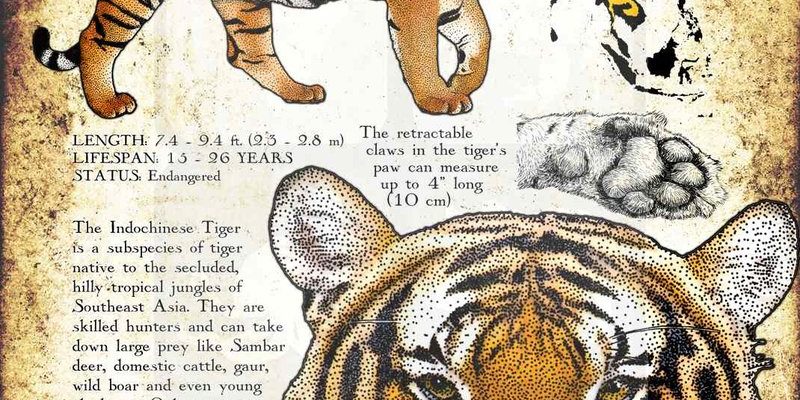
The Indochinese tiger isn’t just another big cat; it’s a unique subspecies that has adapted to the dense forests and mountain ranges of Southeast Asia. Imagine them as the stealthy ninjas of the animal kingdom, camouflaging themselves among the thick foliage, ready to pounce on their unsuspecting prey. But how did they come to be? Let’s delve into their evolutionary history and discover what makes these tigers remarkable.
Origins of the Tiger Family
The history of the tiger family starts millions of years ago. Tigers are part of the *Panthera* genus, which includes other big cats like lions, leopards, and jaguars. It’s believed that all tigers share a common ancestor that roamed the Earth about 2 to 3 million years ago.
The evolutionary journey took tigers to different parts of Asia, where they adapted to various climates and habitats. One of these paths led to the evolution of the Indochinese tiger, which is often found in countries like Thailand, Vietnam, and Cambodia. This unique subspecies has developed physical characteristics that help it thrive in its environment, like a leaner body and dark stripes that provide excellent camouflage in the shadowy forests.
You might be wondering how such adaptations occurred. Through natural selection, those tigers that were better suited for their habitats had a higher chance of surviving and reproducing. Over generations, these traits became ingrained in the genetic makeup of the Indochinese tiger, shaping it into the incredible animal we see today.
Distinct Features of the Indochinese Tiger
The Indochinese tiger isn’t just another pretty face; it has features that distinguish it from other tiger subspecies. One key characteristic is its slimmer body compared to its Siberian cousins. This adaptation allows it to navigate the dense, humid forests of Southeast Asia more easily.
Additionally, their stripe patterns are unique. The stripes of the Indochinese tiger are closer together and darker, which enhances their ability to stay hidden among the underbrush. Think of it as nature’s own design for a stealthy ambush. These traits help them become effective predators in their habitat, stalking deer and wild boar.
Honestly, these adaptations aren’t just about looks—they’re vital for survival. The more a tiger can blend into its environment, the better its chances of hunting successfully. This evolutionary path showcases how biodiversity thrives when species adapt to their surroundings.
Habitat and Distribution
The range of the Indochinese tiger is quite fascinating. These tigers are primarily found in Southeast Asia, dwelling in forests, grasslands, and even mountainous areas. Their habitat is crucial for providing food, shelter, and breeding grounds.
However, the Indochinese tiger’s territory has been shrinking due to human activities. Deforestation, poaching, and habitat fragmentation have drastically reduced their numbers. It’s heartbreaking to think about how much we’ve encroached on their homes.
Here’s the thing: protecting their habitat is essential for ensuring the survival of this majestic species. Conservation efforts are underway, involving park management and anti-poaching initiatives, but it’s a constant battle against the forces threatening their existence.
The Role of Indochinese Tigers in the Ecosystem
Indochinese tigers play a crucial role in their ecosystem. As apex predators, they help maintain the balance of prey populations. When tigers are removed from the equation, herbivore populations can surge, causing overgrazing and destruction of vegetation. This can lead to a domino effect of ecological issues.
Their presence in the ecosystem also benefits other species. For instance, when tigers hunt, they often leave behind carcasses that provide food for scavengers like vultures and hyenas. This interdependence shows how every creature, no matter how big or small, contributes to the health of the environment.
Let me explain further: Imagine a beautifully woven tapestry. Each thread represents a different species, including the Indochinese tiger. If you pull out one thread, the whole tapestry begins to unravel. That thread, the tiger, is essential for keeping the fabric of the ecosystem strong and intact.
Threats to the Indochinese Tiger
Despite their adaptability and strength, Indochinese tigers face significant threats today. One of the primary dangers is poaching. These tigers are hunted for their beautiful pelts and body parts, which are often used in traditional medicine or sold as trophies. It’s hard to fathom that someone would want to harm such a magnificent creature for profit.
On top of poaching, habitat loss is another major hurdle. As forests are cleared for agriculture, urban development, and logging, tigers lose their homes. Without adequate habitat, their chances of survival diminish significantly.
Conservation organizations are working hard to combat these threats. They focus on creating protected areas, raising awareness, and ensuring stricter laws to safeguard these amazing animals. But every effort counts—you can help by supporting wildlife organizations or spreading the word about the plight of the Indochinese tiger.
Conservation Efforts and the Future
Fortunately, there’s hope for the Indochinese tiger. Conservation efforts have ramped up in recent years, focusing on protecting habitats, and reducing poaching, and raising awareness among local communities.
Protected areas like national parks are crucial sanctuaries for these tigers. They provide safe havens where tigers can roam freely and breed. Initiatives such as wildlife corridors also play an essential role in connecting fragmented habitats, allowing tigers to find mates and expand their range.
But here’s the thing—you don’t have to be a wildlife expert to make a difference. Simple actions, like supporting wildlife charities or advocating for sustainable practices, can contribute to the fight for these amazing creatures. The future of the Indochinese tiger relies on all of us working together to ensure they have a place to thrive.
The journey of the Indochinese tiger is a captivating tale of adaptation, resilience, and survival. From their origins millions of years ago to their prominent role in today’s ecosystems, these tigers are more than just beautiful animals—they are a vital part of our planet’s biodiversity.
As we learn about their evolutionary history, we gain a deeper appreciation for the complexities of nature. However, we must also recognize the challenges they face and take action to help protect them. Every small step counts, whether it’s supporting conservation efforts or educating others.
The Indochinese tiger’s story isn’t just about survival; it’s also about our responsibility as stewards of the Earth. Together, we can ensure that future generations can experience the wonder of these extraordinary creatures.

